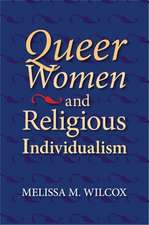Uninvited – Classical Hollywood Cinema and Lesbian Representability
Autor Patricia Whiteen Limba Engleză Paperback – 21 oct 1999
Patricia White, Assistant Professor of English and Film Studies, teaches film and cultural studies at Swarthmore College. Her work has appeared in Screen, The Oxford Guide to Film Studies, and in numerous collections of feminist and lesbian/gay film studies. She is co-editor of a Wide Angle special issue devoted to the work of the feminist film distributor Women make Movies and a member of the editorial collective of Camera Obscura.
Preț: 153.91 lei
Nou
Puncte Express: 231
Preț estimativ în valută:
29.45€ • 32.09$ • 24.82£
29.45€ • 32.09$ • 24.82£
Carte disponibilă
Livrare economică 02-16 aprilie
Livrare express 18-22 martie pentru 30.33 lei
Preluare comenzi: 021 569.72.76
Specificații
ISBN-13: 9780253213457
ISBN-10: 0253213452
Pagini: 396
Ilustrații: 46 b&w photographs
Dimensiuni: 156 x 233 x 19 mm
Greutate: 0.49 kg
Editura: MH – Indiana University Press
ISBN-10: 0253213452
Pagini: 396
Ilustrații: 46 b&w photographs
Dimensiuni: 156 x 233 x 19 mm
Greutate: 0.49 kg
Editura: MH – Indiana University Press
Cuprins
Introduction
Chapter 1: Reading the Code(s)
Chapter 2: Lesbian Cinephilia
Chapter 3: Female Spectator, Lesbian Spectator
Chapter 4: Films for Girls - Lesbian Sentiment and the Maternal Melodrama
Chapter 5: Supporting Character
Chapter 6: On Retrospectatorship
Works Cited
Chapter 1: Reading the Code(s)
Chapter 2: Lesbian Cinephilia
Chapter 3: Female Spectator, Lesbian Spectator
Chapter 4: Films for Girls - Lesbian Sentiment and the Maternal Melodrama
Chapter 5: Supporting Character
Chapter 6: On Retrospectatorship
Works Cited
Recenzii
White (Swarthmore College) seeks traces of lesbian desire and difference in the films of the classic era. Since the Production Code forbade even the slightest hint of sexual deviancy, White must engage in a great deal of what she calls retrospectatorship, with somewhat mixed results. She begins by discussing the Code itself; moves on to a discussion of star personae (e.g., Davis, Hepburn, Dietrich, Garbo), the gothic/horror film and maternal melodrama, overt lesbian overtones among supporting players such as McDaniel, Waters, Fitter, McCambridge, and--especially--Moorehead; and closes with a chapter on retrospectatorship. She draws on all of the major figures in feminist film theory, if only to chastise them for ignoring the lesbian spectator. Since White covers much of the same ground that Mary Ann Doane does in The Desire to Desire: The Woman's Films of the 1940s (CH, Oct'87), she is particularly concerned with correcting Doane's omissions. White writes with considerable flair, and her arguments are always interesting, if not always fully convincing. A useful addition to studies of spectatorship in and of the classic era. Upper--division undergraduates through professionals.W. A./P>--W. A. Vincent, Michigan State University"Choice" (01/01/2000)
Notă biografică
Descriere
Examines masked lesbian representation in Hollywood cinema


















